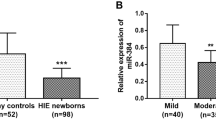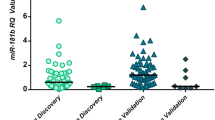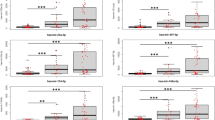Abstract
Neonatal hypoxic-ischemic encephalopathy (HIE) is a disorder mainly due to asphyxia during the perinatal period, and late diagnosis leads to high mortality. In this study, the expression of microRNA-199a (miR-199a) in HIE newborns was investigated, as well as its clinical significance in HIE diagnosis and prognosis. Circulating levels of S100B and NSE in HIE newborns were measured using enzyme-linked immunosorbent assay, and the expression of miR-199a was analyzed using quantitative real-time PCR. The diagnostic value of miR-199a, S100B and NSE was evaluated using the receiver operating characteristic (ROC) analysis, and their prognostic value was assessed by the evaluation of Gesell intellectual development of the HIE newborns. HIE newborns possessed significantly increased levels of S100B and NSE and decreased miR-199a (all P < 0.01). The Neonatal Behavioral Neurological Assessment (NBNA) score of HIE newborns was negatively correlated with S100B and NSE, while was positively correlated miR-199a. The ROC analysis results showed the diagnostic value of serum miR-199a, and the combined detection of miR-199a, S100B and NSE could obtained the highest diagnostic accuracy in HIE newborns. miR-199a expression was lowest in newborns with severe HIE, and it had diagnostic potential to distinguish HIE cases with different severity. Regarding the prognosis of neonatal HIE, the correlation of miR-199a, S100B, NSE with Gesell intellectual development was found in HIE newborns. The decreased miR-199a in HIE newborns serves as a potential diagnostic biomarker and may help to improve the diagnostic and prognostic value of S100B and NSE in neonatal HIE.


Similar content being viewed by others
Data availability
All data analyzed in this study are included in the manuscript.
Abbreviations
- HIE:
-
Hypoxic-ischemic encephalopathy
- miR-199a:
-
MicroRNA-199a
- ROC:
-
Receiver operating characteristic
- NBNA:
-
Neonatal Behavioral Neurological Assessment
- CT:
-
Computed tomography
- MRI:
-
Magnetic resonance imaging
- NSE:
-
Neuron-specific enolase
- miRNAs:
-
MicroRNAs
- ELISA:
-
Enzyme-linked immunosorbent assay
- qRT-PCR:
-
Quantitative real-time PCR
- DQs:
-
Development quotients
- AUC:
-
Area under the curve
- BBB:
-
Blood brain barrier
References
Silveira RC, Procianoy RS (2015) Hypothermia therapy for newborns with hypoxic ischemic encephalopathy. J Pediatr (Rio J) 91(6 Suppl 1):S78–83
Yildiz EP, Ekici B, Tatli B (2017) Neonatal hypoxic ischemic encephalopathy: an update on disease pathogenesis and treatment. Expert Rev Neurother 17(5):449–459
Wang Z, Liu Y, Shao M, Wang D, Zhang Y (2018) Combined prediction of miR-210 and miR-374a for severity and prognosis of hypoxic-ischemic encephalopathy. Brain Behav 8(1):e00835
Douglas-Escobar M, Weiss MD (2015) Hypoxic-ischemic encephalopathy: a review for the clinician. JAMA Pediatr 169(4):397–403
Natarajan G, Pappas A, Shankaran S (2016) Outcomes in childhood following therapeutic hypothermia for neonatal hypoxic-ischemic encephalopathy (HIE). Semin Perinatol 40(8):549–555
Groenendaal F, de Vries LS (2017) Fifty years of brain imaging in neonatal encephalopathy following perinatal asphyxia. Pediatr Res 81(1–2):150–155
Pei XM, Gao R, Zhang GY, Lin L, Wan SM, Qiu SQ (2014) Effects of erythropoietin on serum NSE and S-100B levels in neonates with hypoxic-ischemic encephalopathy. Zhongguo Dang Dai Er Ke Za Zhi 16(7):705–708
Alshweki A, Perez-Munuzuri A, Lopez-Suarez O, Bana A, Couce ML (2017) Relevance of urinary S100B protein levels as a short-term prognostic biomarker in asphyxiated infants treated with hypothermia. Med (Baltimore) 96(44):e8453
Azuma J, Nabatame S, Nakano S, Iwatani Y, Kitai Y, Tominaga K et al (2015) Prognostic factors for acute encephalopathy with bright tree appearance. Brain Dev 37(2):191–199
Lu TX, Rothenberg ME (2018) MicroRNA. J Allergy Clin Immunol 141(4):1202–1207
Mohr AM, Mott JL (2015) Overview of microRNA biology. Semin Liver Dis 35(1):3–11
Skala M, Hanouskova B, Skalova L, Matouskova P (2019) MicroRNAs in the diagnosis and prevention of drug-induced cardiotoxicity. Arch Toxicol 93(1):1–9
Tavakolizadeh J, Roshanaei K, Salmaninejad A, Yari R, Nahand JS, Sarkarizi HK et al (2018) MicroRNAs and exosomes in depression: potential diagnostic biomarkers. J Cell Biochem 119(5):3783–3797
Looney AM, Walsh BH, Moloney G, Grenham S, Fagan A, O’Keeffe GW et al (2015) Downregulation of umbilical cord blood levels of miR-374a in neonatal hypoxic ischemic encephalopathy. J Pediatr 167(2):269–73e2
Looney AM, O'Sullivan MP, Ahearne CE, Finder M, Felderhoff-Mueser U, Boylan GB et al (2019) Altered expression of umbilical cord blood levels of miR-181b and its downstream target mUCH-L1 in infants with moderate and severe neonatal hypoxic-ischaemic encephalopathy. Mol Neurobiol 56(5):3657–3663
O’Sullivan MP, Looney AM, Moloney GM, Finder M, Hallberg B, Clarke G et al (2019) Validation of altered umbilical cord blood microrna expression in neonatal hypoxic-ischemic encephalopathy. JAMA Neurol 76(3):333–341
Li M, Luan L, Liu Q, Liu Y, Lan X, Li Z et al (2019) MiRNA-199a-5p protects against cerebral ischemic injury by down-regulating DDR1 in rats. World Neurosurg 131:e486–e494
Yin WL, Yin WG, Huang BS, Wu LX (2019) LncRNA SNHG12 inhibits miR-199a to upregulate SIRT1 to attenuate cerebral ischemia/reperfusion injury through activating AMPK signaling pathway. Neurosci Lett 690:188–195
Sarnat HB, Sarnat MS (1976) Neonatal encephalopathy following fetal distress. A clinical and electroencephalographic study. Arch Neurol 33(10):696–705
Group of N, Chinese Pediatric S, Chinese Medical A (2005) Diagnostic criteria for neonatal hypoxic-ischemic encephalopathy. Zhonghua Er Ke Za Zhi 43(8):584
Zaigham M, Lundberg F, Olofsson P (2017) Protein S100B in umbilical cord blood as a potential biomarker of hypoxic-ischemic encephalopathy in asphyxiated newborns. Early Hum Dev 112:48–53
Douglas-Escobar M, Weiss MD (2012) Biomarkers of hypoxic-ischemic encephalopathy in newborns. Front Neurol 3:144
Massaro AN, Wu YW, Bammler TK, Comstock B, Mathur A, McKinstry RC et al (2018) Plasma biomarkers of brain injury in neonatal hypoxic-ischemic encephalopathy. J Pediatr 194(67–75):e1
Okumus N, Turkyilmaz C, Onal EE, Atalay Y, Serdaroglu A, Elbeg S et al (2008) Tau and S100B proteins as biochemical markers of bilirubin-induced neurotoxicity in term neonates. Pediatr Neurol 39(4):245–252
Chong ZZ (2016) S100B raises the alert in subarachnoid hemorrhage. Rev Neurosci 27(7):745–759
Koh SX, Lee JK (2014) S100B as a marker for brain damage and blood-brain barrier disruption following exercise. Sports Med 44(3):369–385
Lindblad C Nelson DW Zeiler FA Ercole A Ghatan PH von Horn H et al. (2020) Influence of blood-brain barrier integrity on brain protein biomarker clearance in severe traumatic brain injury: a longitudinal prospective study. J Neurotrauma 37(12):1381–1391
Ehler J, Saller T, Wittstock M, Rommer PS, Chappell D, Zwissler B et al (2019) Diagnostic value of NT-proCNP compared to NSE and S100B in cerebrospinal fluid and plasma of patients with sepsis-associated encephalopathy. Neurosci Lett 692:167–173
Streitberger KJ, Leithner C, Wattenberg M, Tonner PH, Hasslacher J, Joannidis M et al (2017) Neuron-specific enolase predicts poor outcome after cardiac arrest and targeted temperature management: a multicenter study on 1053 patients. Crit Care Med 45(7):1145–1151
Lv H, Wang Q, Wu S, Yang L, Ren P, Yang Y et al (2015) Neonatal hypoxic ischemic encephalopathy-related biomarkers in serum and cerebrospinal fluid. Clin Chim Acta 450:282–297
Yao B, Zhang LN, Ai YH, Liu ZY, Huang L (2014) Serum S100beta is a better biomarker than neuron-specific enolase for sepsis-associated encephalopathy and determining its prognosis: a prospective and observational study. Neurochem Res 39(7):1263–1269
Kosaka N, Iguchi H, Ochiya T (2010) Circulating microRNA in body fluid: a new potential biomarker for cancer diagnosis and prognosis. Cancer Sci 101(10):2087–2092
Li B, Dasgupta C, Huang L, Meng X, Zhang L (2019) MiRNA-210 induces microglial activation and regulates microglia-mediated neuroinflammation in neonatal hypoxic-ischemic encephalopathy. Cell Mol Immunol. https://doi.org/10.1038/s41423-019-0257-6
Jiang G, Zhou R, He X, Shi Z, Huang M, Yu J et al (2016) Expression levels of microRNA-199 and hypoxia-inducible factor-1 alpha in brain tissue of patients with intractable epilepsy. Int J Neurosci 126(4):326–334
Funding
Not applicable.
Author information
Authors and Affiliations
Contributions
ML and GZ designed the study, analyzed the clinical data and wrote the manuscript. MY collected the clinical data of the infants.
Corresponding author
Ethics declarations
Conflict of interests
The authors declare that they have no competing interests.
Ethics approval and consent to participate
The protocols of this study were approved by the Ethics Committee of Maternal and Child Health Hospital of Linyi and written informed consent was obtained from each infant’s parents.
Consent for publication
The consent for publication was obtained.
Additional information
Publisher's Note
Springer Nature remains neutral with regard to jurisdictional claims in published maps and institutional affiliations.
Rights and permissions
About this article
Cite this article
Li, M., Ye, M. & Zhang, G. Aberrant expression of miR-199a in newborns with hypoxic-ischemic encephalopathy and its diagnostic and prognostic significance when combined with S100B and NSE. Acta Neurol Belg 121, 707–714 (2021). https://doi.org/10.1007/s13760-020-01408-0
Received:
Accepted:
Published:
Issue Date:
DOI: https://doi.org/10.1007/s13760-020-01408-0




